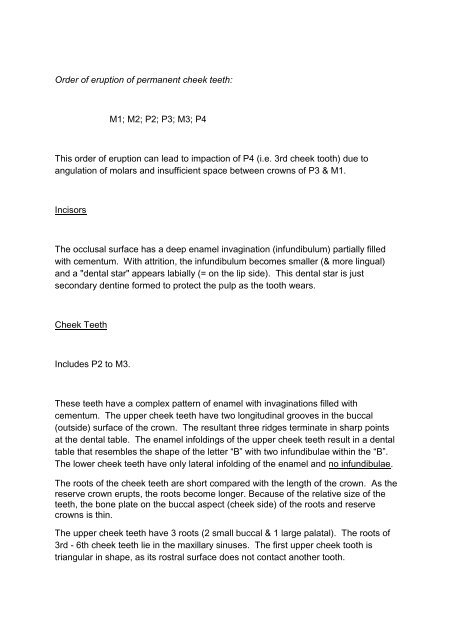Anatomy, physiology, ageing & nomenclature for equine dentistry.
Anatomy, physiology, ageing & nomenclature for equine dentistry.
Anatomy, physiology, ageing & nomenclature for equine dentistry.
Create successful ePaper yourself
Turn your PDF publications into a flip-book with our unique Google optimized e-Paper software.
Order of eruption of permanent cheek teeth:M1; M2; P2; P3; M3; P4This order of eruption can lead to impaction of P4 (i.e. 3rd cheek tooth) due toangulation of molars and insufficient space between crowns of P3 & M1.IncisorsThe occlusal surface has a deep enamel invagination (infundibulum) partially filledwith cementum. With attrition, the infundibulum becomes smaller (& more lingual)and a "dental star" appears labially (= on the lip side). This dental star is justsecondary dentine <strong>for</strong>med to protect the pulp as the tooth wears.Cheek TeethIncludes P2 to M3.These teeth have a complex pattern of enamel with invaginations filled withcementum. The upper cheek teeth have two longitudinal grooves in the buccal(outside) surface of the crown. The resultant three ridges terminate in sharp pointsat the dental table. The enamel infoldings of the upper cheek teeth result in a dentaltable that resembles the shape of the letter “B” with two infundibulae within the “B”.The lower cheek teeth have only lateral infolding of the enamel and no infundibulae.The roots of the cheek teeth are short compared with the length of the crown. As thereserve crown erupts, the roots become longer. Because of the relative size of theteeth, the bone plate on the buccal aspect (cheek side) of the roots and reservecrowns is thin.The upper cheek teeth have 3 roots (2 small buccal & 1 large palatal). The roots of3rd - 6th cheek teeth lie in the maxillary sinuses. The first upper cheek tooth istriangular in shape, as its rostral surface does not contact another tooth.

















